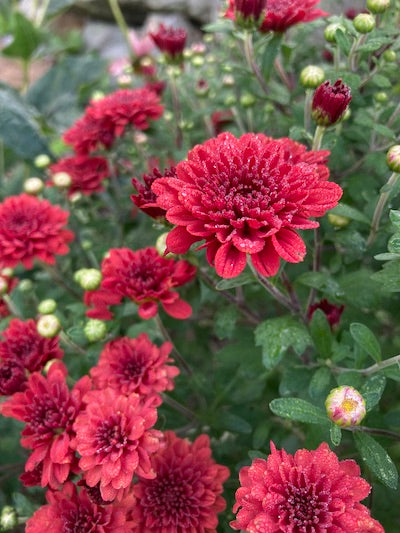Change of Seasons, Change of Colors
Share
I recently moved my houseplants* from their summer vacation spots on my patio to their homes indoors, trimmed off the tired-looking parts of my flowering combination containers and harvested a bunch of herbs and veggies from various pots outside. When I was done, my summery outdoor space had suddenly become bland. This change of summer to fall calls for a change of color.
Our musings this month offer plenty of suggestions for ways to dress those now-empty spots on your deck or in your garden with fall-appropriate attire. Summer may be officially over in a few weeks but the growing season will keep going for a month or two more. Squeeze all you can out of it with a mix-and-match assortment of the following suggestions.
Annuals for Fall Color
In the northern and Mid-Atlantic regions, we have many flowering and foliage annuals that can stand up to and even thrive in the cycles of warm days and cool nights of fall. Some can even handle a bit of frost. Couple these attributes with the warm hues of autumn—darker reds, rich oranges, golden yellows, khaki greens and browns—and you have a line-up of plants that’ll give you many weeks more—months, even!—of seasonal décor.

Chrysanthemums. Probably the most well-known of the fall flowering annuals, mums add quick orbs of color and immediately indicate that yes, indeed, it is now fall. Keep in mind that mums come in early, middle and late-season types, so if you pot up mums early on in the fall they may cycle out of color by late October. That’s okay, because you can find them at your garden center all season long.
Ornamental kale. The ornamental version of kale is a little tougher than the edible varieties, but it adds that curly-leaved texture to a fall planting. The leaves of many varieties have the bonus of being two-toned, usually with greenish outer leaves and more purply center leaves.
Ornamental peppers. If ever there was a plant that looked like those old-timey outdoor Christmas lights, this would be the one. And like Christmas lights, these plants add reds and oranges and purples to any pot they are in. Plus, they’re just real fun.

Pansies. Yes, we in the north usually associate pansies with spring, but their range of colors outside of the springy pastels are spot-on for fall. And if you give them a good mulching, you may be able to overwinter them until spring. Plus, their flowers are edible, too! Sprinkle them over salads for a touch of color.
Pinks. Also known as garden carnations, pinks can take a good spell of cool weather with no problem. And if planted in a combination container, they add that much-needed spot of color here and there. And they are not just pink! They come in a range from darker red to white. Some varieties even have that familiar carnation fragrance.
Strawflowers. The petals of this flower are fun in that they are stiff and irresistibly touchable. Added bonus: they come in the typical fall colors of yellow, orange and red (and some whites and pinks, too).

Edible kale and Swiss chard. A late-summer planting of kale and Bright Lights Swiss chard (which we told you about HERE) will be coming into its own in the next few weeks. The bluish greens of the kale, bright greens of the chard leaves and the rainbow of its stem colors sometimes make it a shame to remove it from the garden, it’s all just so pretty. But you know what? They look good on your dinner plate and salad bowls, too.
Perennials for Fall Color
Perennials not only provide short-term color but also add long-term value by blooming year after year. And bonus—perennials usually grow bigger each year, too. Some perennials I enjoy in my fall décor are:
Heuchera. These are probably the epitome of fall foliage colors. From the black curly foliage of ‘Black Taffeta’ to the caramel colors of ‘Toffee Tart’ and the autumn tree-like colors of ‘Ginger Ale’, there literally is a heuchera for every fall mood.
New England asters. These guys are a pop of tall purple in a sea of moody hues. Get some. They’ll make you smile.

Stonecrops. A darker dusty rose flower with light green leaves is the typical sedum coloration, but newer varieties on the market include darker flowers and darker stems. Try those for something different.

Ornamental grasses. Many of the perennial ornamental grasses really put on a show as autumn comes. Green grass blades turn to hues of browns and reds, their puffy flower heads expand as seeds and the fall winds stir them beautifully in the garden. Try planting native grasses to encourage local ecosystems. They look just as beautiful as their non-native cousins.
Subbing In Soils

All of these items above look lovely in containers. Don’t forget that when you change out your summer plantings for more fall-flavored items, refreshing or even completely changing out your containers’ potting soil is a good idea. And we’re saying that not just because we sell Premium Blend Potting Soil. We’re saying it because the process adds life and longevity to the plants going in.
* PSST! Pro Tip! Since you’re bringing houseplants indoors from their summer stay outside, now’s a great time to place a ½” layer of rice hulls on the surface of your houseplants before bringing them inside. This deters those pesky flying critters called fungus gnats. The rice hulls act as a physical barrier, preventing the adults from getting into, or out of, the soil. Even the USDA says it’s so! The rice hulls won’t kill the gnats (you’ll need diatomaceous earth or nematodes for that) but they will deter the fungus gnats from reaching your plants’ baby roots. Buy a few bags of our pure rice hulls HERE.



